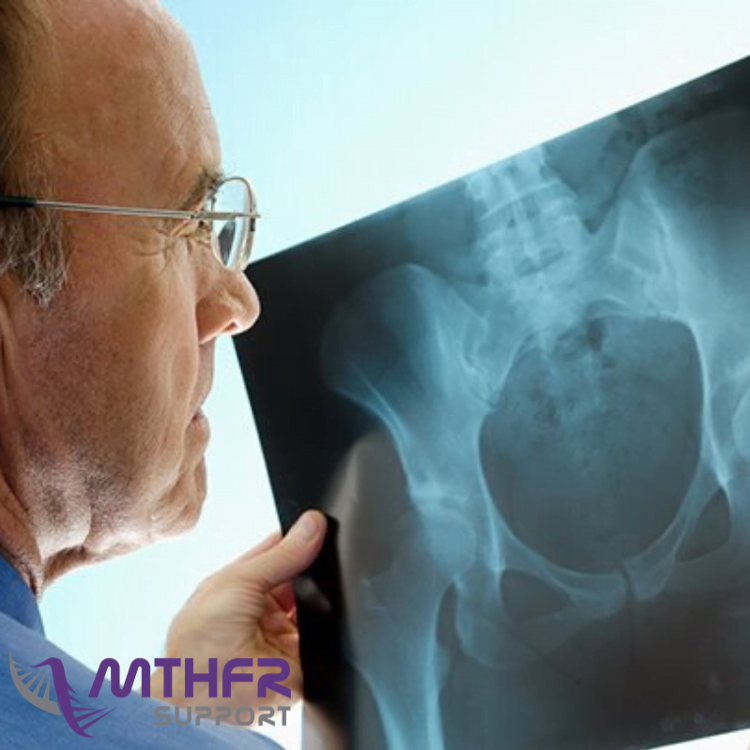Homocysteine (Hcy) is a sulphur-containing amino acid, which is derived during methionine metabolism and this is the only way it is produced in the body. An enzyme, S-adenosyl-L-methionine (SAM) synthetase, catalyses this process and is also a methyl donor for the synthesis of different compounds, such as proteins, nucleic acids and polyamines. Therefore it’s essential to our everyday biochemistry.
SAM also plays a crucial role in the processes involved in gene modulation, such as regulation of DNA methylation, RNA editing, chromatin (genetic material) remodelling and others. To complete the methyl cycle, 5-methyl tetrahydrofolate reductase (5-MTHFR) enzyme donates a methyl group to Hcy to convert it back to methionine and balances Hcy levels. This process occurs in all the body cells as well as specific organs, such as the liver, kidney, lens, brain etc. Although Hcy is formed in all tissues, its detoxification occurs in the liver, kidney, small intestine, pancreas and lens. Hence, dysfunction at any level of Hcy metabolism, especially reduction in MTHFR enzyme activity, can result in abnormally high Hcy levels.
Homocysteine levels: What is normal and abnormal?
Reference range of Hcy in the body is usually 5-15 𝝻mol/L.1 We consider the optimal range to be 7-8 𝝻mol/L. Elevated levels of homocysteine is known as hyperhomocysteinaemia (HHcy). HHcy can be mild (15-30 𝝻mol/L), moderate (30-100 𝝻mol/L) or severe (>100 𝝻mol/L). Although Hcy is very important for a number of metabolic processes, excess can actually be harmful to your body. Some of the diseases associated with high Hcy levels are cardiovascular (heart and blood vessel-related) disease, cerebrovascular (brain-related) disease, neurological and psychiatric disorders, bone damage, kidney disease, digestive system-related disorders, cancer, reproductive disorders, and congenital defects. Besides these diseases, HHcy is also associated with increased protein, nucleic acid, and carbohydrate breakdown, which have been found to be toxic for cells and tissues of the body. In this blog, we will discuss Hcy and its role in the development of various diseases.
Cerebrovascular disease
When Hcy level is high, it abnormally starts binding with protein, a process known as homocysteinylation.2 As a result, it alters or impairs protein structure and function. Some of the targeted proteins to which Hcy binds to are blood, immune system, and clotting-related proteins. High Hcy and protein impairment have direct consequences on genetic defects related to metabolising Hcy or methionine. The abnormal proteins can also cause cell toxicity, reduced enzyme activity, protein degradation, and so on, which further result in high risk of stroke and associated nerve damage.2,7

As we have mentioned before, abnormal protein formation occurs due to high Hcy levels. These proteins act as antigens, which cause triggering of the immune system. This autoimmune response results in the activation of special immune system cells (macrophages), which are responsible for repetitive blood vessel wall damage.
Since high Hcy levels also affect the repairing ability of the blood vessel, the blood clotting mechanism also gets affected and causes abnormal blood clot formation in different areas of the body including the vessel supplying the heart. Abnormal blood clots eventually cause stiffening of the blood vessel wall and increase the risk of developing high blood pressure. Research shows that a 2.5 𝝻M rise in the total Hcy levels results in a 10% increase in cardiovascular disease risk.2,3,5,6
Psychiatric disorders
Studies have shown that there exists a positive relationship between high Hcy level and the presence of psychiatric disorders, such as Alzheimer’s and Parkinson’s disease, depression, anxiety, and so on. In fact, high Hcy levels are associated with a 26% increase in developing the symptoms of depression.
Presence of high Hcy levels affects the functions of some chemicals (neurotransmitters) that regulate nerve cell functioning and the conduction of signals through them. Also, high Hcy disrupts the protective blood-brain barrier, which can further lead to the development or progression of Alzheimer’s disease, autism and decline in cognitive functions. In fact, autism is has been linked to MTHFR polymorphisms, which hamper homocysteine metabolism.2,7
Kidney Disease
High Hcy levels in the body also increase the accumulation of homocysteine in kidney cells. The kidneys also receive and filter large amounts of Hcy from the blood. In case of abnormally high Hcy levels, Hcy starts appearing in the urine, a condition known as homocystinuria.
High intracellular homocysteine levels speed up the formation of reactive species and suppress the activity of antioxidants in the kidney cells, which ultimately cause kidney cell destruction and impaired kidney function. In the case of unchecked Hcy levels, it can ultimately result in kidney failure.2,7
Bone damage
Hcy is important in the production of osteoclasts and bone marrow cells. Osteoclasts are involved in resorption of the bone so that new bone can be deposited on a regular basis. However, when Hcy levels are high, more osteoclasts are formed along with the accumulation of large amounts of reactive species. These reactive species prevent the osteoclasts from dying , causing bone resorption resulting in an increased risk of fractures and a low bone mineral density. 

In addition to that, dysfunctional bone marrow cell production also disrupts the normal bone repair process. Not only that but Hcy starts accumulating in the bones making them spongy and compromising bone strength.2
Digestive system-related disorders
Research shows that high Hcy levels are found in people with constipation, bowel inflammation and colorectal cancer. The reactive species formed in the gut cause remodelling of the gut lining. Also, in the presence of an MTHFR polymorphism, abnormal blood clots form in the blood vessels present in the gut, which ultimately causes intestinal injury. Thus, in the case of hyperhomocysteinaemia, constant irritation and inflammation of the gut occurs, which can develop into long-term digestive system-related disorders mentioned above.2
High Hcy levels have a bi-directional effect on cancer development. Firstly, due to low intracellular SAM levels, the activity of genes that suppress tumour formation gets reduced. Secondly, it also results in the activation of tumour-promoting genes. Hence, it increases the risk of cancer development, such as breast cancer, in a person already at risk and with high homocysteine levels.4,7
Reproductive disorders and congenital defects
The development of reproductive and congenital defects is a result of the cumulative effect of high Hcy levels and the conditions that develop as a result of it. High Hcy levels affect the reproductive system of both men and women. In the presence of MTHFR polymorphism or high Hcy levels, a series of events can occur progressively or individually, such as low-quality egg and sperm production, degradation of cells that nurture the eggs, low motility and count of sperm, faulty sperm DNA production, and so on.
Also, due to abnormal blood clot formation, the nutrient supply to the embryo can be reduced or blocked resulting in recurrent abortions and high blood pressure during pregnancy. Since the methionine cycle is not completed, the availability of folate is inadequate, which has been associated with the development of neural tube defects in the baby.2,7
We’ve learnt about high homocysteine but what about low homocysteine?
As we’ve said, homocysteine levels ideally should sit between 7-8 umol/L.
Low homocysteine, in our book, is just as bad as high homocysteine. Why? When the availability of methionine is reduced, it lowers the conversion of methionine to cysteine (a process where homocysteine is produced) or when the cystathionine beta synthase enzyme is overactive as in Down’s syndrome and autism, it results in lowering of homocysteine levels. When the levels fall below 4 𝝻mol/L, they cause glutathione deficiency.9,10
Glutathione is important to fight oxidative stress and toxin exposure in all the organs of the body. In the presence of critically low glutathione levels, the development of diseases related to almost every major bodily system occurs. These include reduced liver detoxification, decreased clearance of alcohol, steroids, hormones, drugs.10
Also, since methionine is crucial for new DNA, RNA, protein, and tissue formation, lipid and protein metabolism, its deficiency results in the development of diseases related to the liver, lungs, kidney, heart, nerves, muscles, digestive system, urinary system, and so on.11
Homocysteine is an important health indicator and its high level in the body is associated with multiple diseases and their risk factors. Some of these diseases not only impact your health but also your pregnancy and ultimately, the health of your baby. Therefore, it is necessary that your practitioner is regularly checking your homocysteine levels to ensure the level is in the optimal range.. Homocysteine can be checked via a blood test, however make sure you go to a reliable lab as testing is tricky and the lab needs to be collecting, processing and storing the samples correctly. Homocystiene should always be tested in a fasted state.
References
- https://www.ncbi.nlm.nih.gov/pmc/articles/PMC5741875/
- https://www.ncbi.nlm.nih.gov/pmc/articles/PMC5085763/
- https://www.nature.com/articles/3780275
- https://www.nature.com/articles/s12276-019-0216-4
- https://www.ncbi.nlm.nih.gov/pmc/articles/PMC4326479/
- http://www.jdrntruhs.org/article.asp?issn=2277-8632;year=2012;volume=1;issue=3;spage=139;epage=147;aulast=Uppala
- https://www.greatplainslaboratory.com/homocysteine-test
- https://www.drkarafitzgerald.com/2017/04/04/low-homocysteine-concern/
- http://www.peirsoncenter.com/uploads/6/0/5/5/6055321/significance-of-low-plasma-homocysteine.pdf













